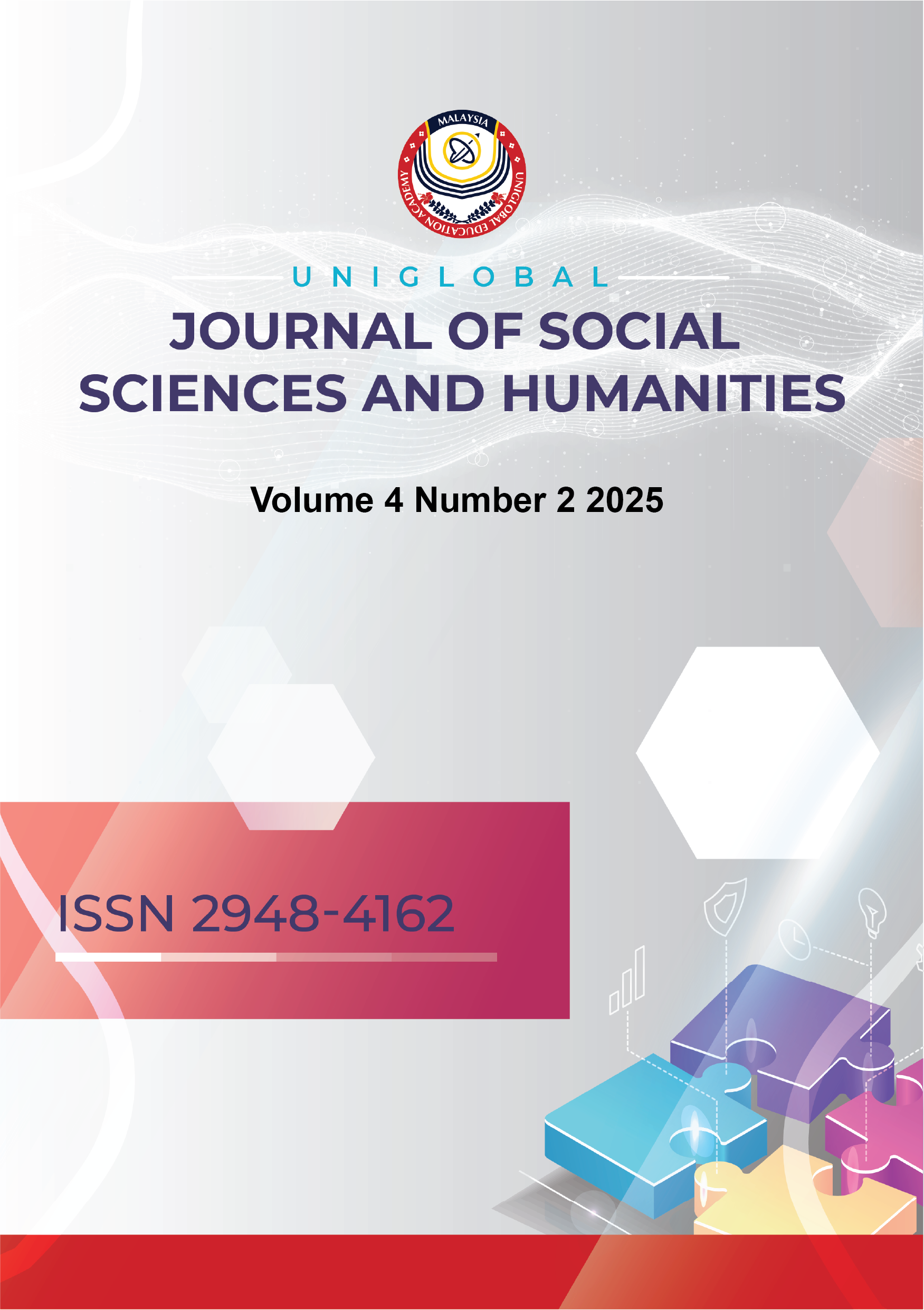The Aesthetics of Line and Form: Formal Language in Yigong Wood Sculpture of Wang Grand Courtyard
DOI:
https://doi.org/10.53797/ujssh.v4i2.9.2025Keywords:
Wood sculpture Art, Yigong, Traditional Chinese Fine Arts, Decorative Aesthetics, Formal LanguageAbstract
This study focuses on the yigong (bracket arms) wood sculpture in the Wang Grand Courtyard in Shanxi Province, approaching the subject from the perspective of fine arts to explore their aesthetic characteristics and visual expression mechanisms within the context of traditional Chinese architectural decoration. As both essential structural connectors and highly ornamental sculptural elements, yigong exemplifies the integration of architecture and art. Through image line-drawing analysis, field observation, and interviews, this research systematically analyzes their compositional strategies, linear organization, and cultural symbolism. The findings reveal that these motifs construct a formal and symbolic visual language between structure and narrative, embodying the traditional Chinese aesthetic ideal of “harmony between form and spirit” and “meaning beyond words.” The study adopts theoretical frameworks from aesthetic scholars to analyze the formal beauty and cultural significance of yigong sculpture from the dimensions of “significant form,” “rhythmic order,” and “symbolic signification.” By examining the yigong sculpture of the Wang Grand Courtyard in depth, the research reveals their visual guidance function in spatial decoration, their narrative function in conveying ethical values, and their symbolic function in representing social identity—demonstrating the multifaceted interaction between decorative art, architectural space, and social consciousness. This research concludes that yigong wood sculpture, as a representative form of traditional Chinese decorative art, are not only the product of exquisite craftsmanship but also a visual narrative system that embodies historical memory and aesthetic concepts. Their refined composition, abstract formal language, and integration of cultural symbols reflect a unique path of artistic expression within architectural contexts, offering significant inspiration and resources for contemporary art design and cultural heritage revitalization.
References
Atkinson, M., Roca, I., & Kilby, D. (2014). Foundations of General Linguistics (RLE Linguistics A: General Linguistics). Routledge.
Barthes, R., & Lavers, A. (2000). Myth today (1957). The Routledge Language and Cultural Theory Reader, 410.
Bell, C. (2018). The aesthetic hypothesis. In Modern Art and Modernism (pp. 67-74). Routledge.
Brubaker, D. A., Wang, C., Brubaker, D. A., & Wang, C. (2015). Philosophy of Chinese Ink Art. Jizi and His Art in Contemporary China: Unification, 59-72. https://doi.org/10.1007/978-3-662-44929-5_5
Clunas, C. (1997). Art in China. Oxford University Press, USA.
Danto, A. C. (1974). The transfiguration of the commonplace. The Journal of Aesthetics and Art Criticism, 33(2), 139-148. https://doi.org/10.2307/429082
De Saussure, F. (2006). Writings in general linguistics. Oxford University Press.
Gell, A. (1998). Art and agency: an anthropological theory. Clarendon Press.
Jiren, F. (2007). Bracketing likened to flowers, branches and foliage: architectural metaphors and conceptualization in tenth to twelfth-century china as reflected in the" Yingzao Fashi". T'oung Pao, 369-432.
Langer, S. K., & . Langer. (1953). Feeling and form (Vol. 3). London: Routledge and Kegan Paul.
Li, N. (2024). The Micro Narrative Language Embodied by Shapes in Contemporary Sculpture Art. Cultura: International Journal of Philosophy of Culture and Axiology, 21(1), 386-402.
Li, Z. (2017). The Chinese aesthetic tradition. University of Hawaii Press.
Liang, S., & Wang, J. P. (2013). Analysis on the Decoration of Traditional Dwellings in Shanxi Province-Taking Dwellings in Ding Village of Xiangfen County as an Example. Advanced Materials Research, 634, 2761-2764.
https://doi.org/10.4028/www.scientific.net/AMR.634-638.2761
Liang, S. (1998). Zhongguo jianzhu shi [History of Chinese Architecture]. Tianjin: Baihua.
Rawson, J. (1985). KC Chang: Art, myth, and ritual: the path to political authority in ancient China. xii, 142 pp. Cambridge, Mass.: Harvard University Press, 1983.£ 15.70. Bulletin of the School of Oriental and African Studies, 48(3), 589-590. https://doi.org/10.1017/S0041977X00038933
Sizheng Fan, K. (2009). Culture for sale: western classical architecture in China’s recent building boom. Journal of Architectural Education, 63(1), 64-74. https://doi.org/10.1111/j.1531-314X.2009.01029.x
Steinhardt, N. S. (2014). Chinese architectural history in the twenty-first century. Journal of the Society of Architectural Historians, 73(1), 38-60. https://doi.org/10.1525/jsah.2014.73.1.38
Tuffour, I. (2017). A critical overview of interpretative phenomenological analysis: A contemporary qualitative research approach. Journal of healthcare communications, 2(4), 52. https://doi.org/10.4172/2472-1654.100093
Wang, J., Cui, Z., Yu, L., Xu, R., & Yang, Q. (2022, July). Analysis of the seismic behavior of traditional Chinese timber structures in the Tang Dynasty. In Structures (Vol. 41, pp. 447-462). Elsevier. https://doi.org/10.1016/j.istruc.2022.05.007
Weitz, M. (2017). The role of theory in aesthetics. In Aesthetics (pp. 512-517). Routledge. https://doi.org/10.4324/9781315303673-103
Woon, C. C., Patron, E. C. P., & Boo, W. Q. (2022). The significance of ‘absence-void space’in Chinese traditional painting. Asian Journal of Arts, Culture and Tourism, 4(3), 51-73.
Yang, L. (2023). Fifteen lectures on Chinese philosophy. Springer.
You, C. (2020). Application of landscape sculpture in interior design—taking wood carving as an example. Open Access Library Journal, 7(08), 1-5. https://doi.org/10.4236/oalib.1106709
Zarchi, R. K., & Levine Keini, N. (2024). Presentational symbolism and the anorexic true-self: working with metaphoric associative cards. Psychodynamic Practice, 30(2), 165-179. https://doi.org/10.1080/14753634.2023.2291880
Downloads
Published
How to Cite
Issue
Section
License
Copyright (c) 2025 Liu Hong, Harozila Ramli

This work is licensed under a Creative Commons Attribution-NonCommercial-ShareAlike 4.0 International License.



